Strategic HRM Report: Unilever's Approach to Employee Management
VerifiedAdded on 2019/12/04
|17
|5138
|529
Report
AI Summary
This report provides a comprehensive analysis of human resource management (HRM) practices, focusing on a case study of Unilever. It begins by introducing the importance of HRM and its role in organizational success, emphasizing the need for effective personnel management. The report then delves into Task 1, applying Guest's Model of HRM to Unilever, examining strategies, practices, outcomes, and financial implications. Task 2 explores the concept of flexibility in the workplace, analyzing different types of flexibility, flexible working practices, and their impact on labor markets. Task 3 addresses equal opportunities, discussing forms of discrimination, legal implications, and approaches to managing diversity. Task 4 covers performance management methods, employee welfare, health and safety legislation, and the impact of topical issues on HR practices. The report concludes by summarizing the key findings and implications for effective HRM within Unilever, highlighting the strategic importance of managing human resources for organizational success.
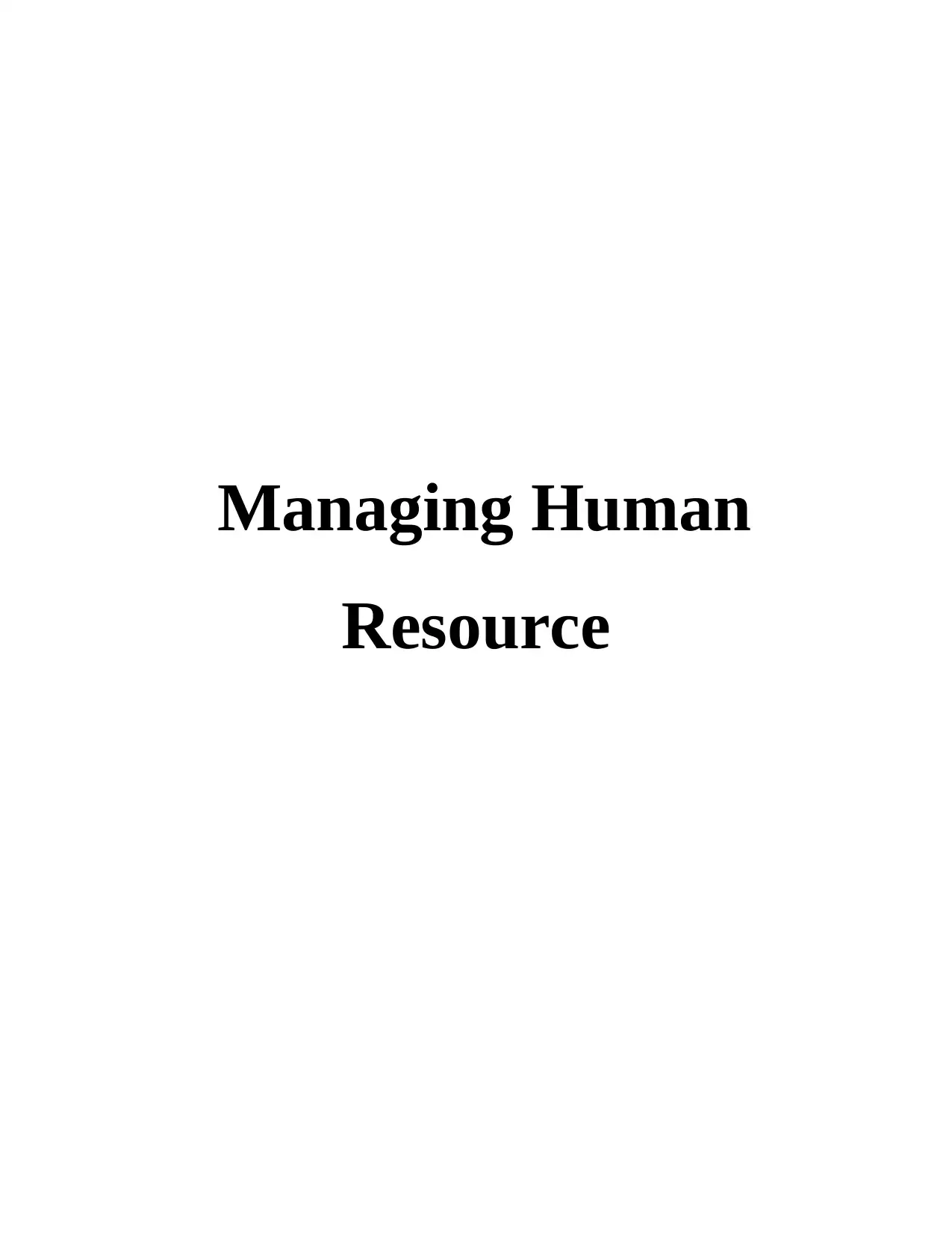
Managing Human
Resource
Resource
Paraphrase This Document
Need a fresh take? Get an instant paraphrase of this document with our AI Paraphraser
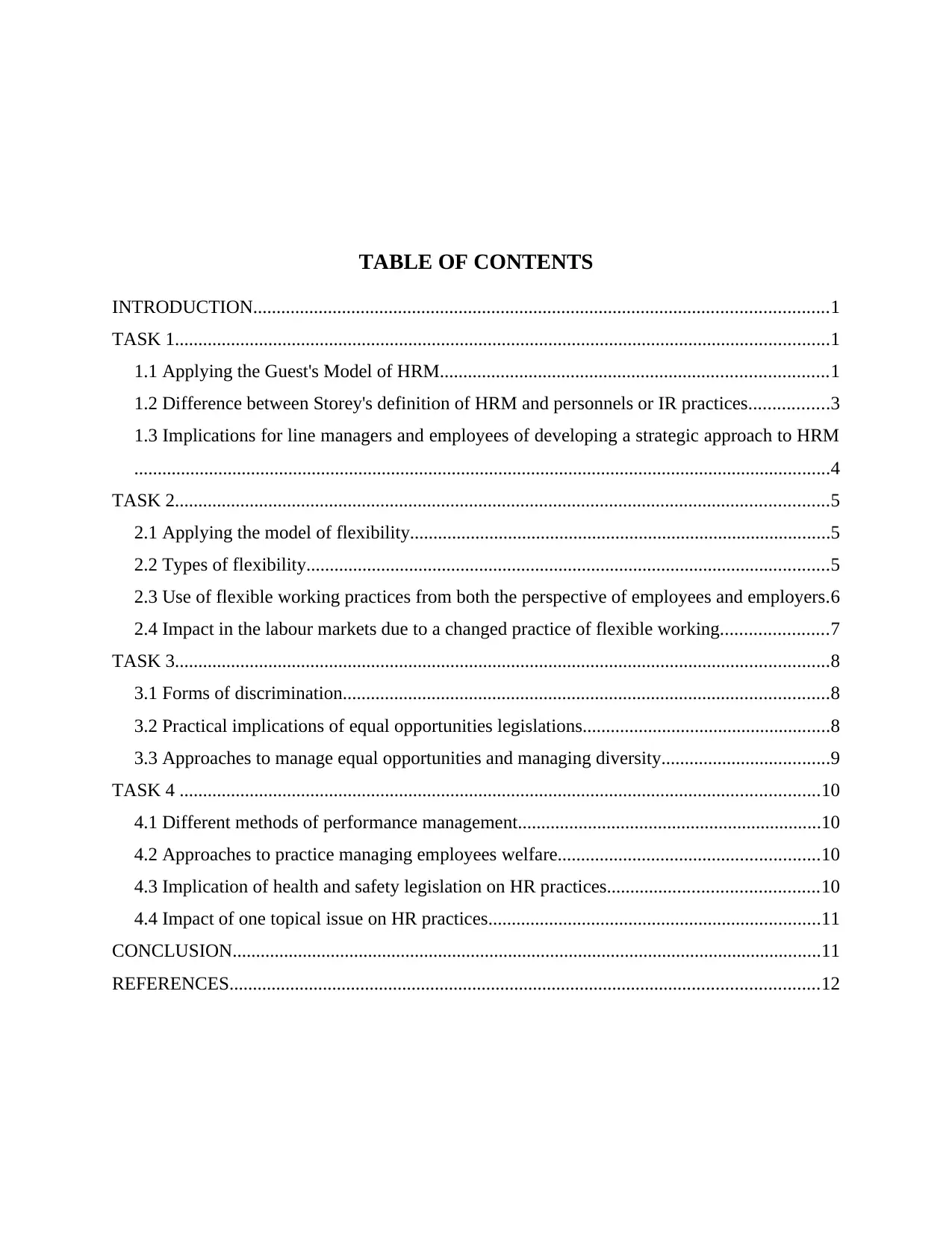
TABLE OF CONTENTS
INTRODUCTION...........................................................................................................................1
TASK 1............................................................................................................................................1
1.1 Applying the Guest's Model of HRM...................................................................................1
1.2 Difference between Storey's definition of HRM and personnels or IR practices.................3
1.3 Implications for line managers and employees of developing a strategic approach to HRM
.....................................................................................................................................................4
TASK 2............................................................................................................................................5
2.1 Applying the model of flexibility..........................................................................................5
2.2 Types of flexibility................................................................................................................5
2.3 Use of flexible working practices from both the perspective of employees and employers.6
2.4 Impact in the labour markets due to a changed practice of flexible working.......................7
TASK 3............................................................................................................................................8
3.1 Forms of discrimination........................................................................................................8
3.2 Practical implications of equal opportunities legislations.....................................................8
3.3 Approaches to manage equal opportunities and managing diversity....................................9
TASK 4 .........................................................................................................................................10
4.1 Different methods of performance management.................................................................10
4.2 Approaches to practice managing employees welfare........................................................10
4.3 Implication of health and safety legislation on HR practices.............................................10
4.4 Impact of one topical issue on HR practices.......................................................................11
CONCLUSION..............................................................................................................................11
REFERENCES..............................................................................................................................12
INTRODUCTION...........................................................................................................................1
TASK 1............................................................................................................................................1
1.1 Applying the Guest's Model of HRM...................................................................................1
1.2 Difference between Storey's definition of HRM and personnels or IR practices.................3
1.3 Implications for line managers and employees of developing a strategic approach to HRM
.....................................................................................................................................................4
TASK 2............................................................................................................................................5
2.1 Applying the model of flexibility..........................................................................................5
2.2 Types of flexibility................................................................................................................5
2.3 Use of flexible working practices from both the perspective of employees and employers.6
2.4 Impact in the labour markets due to a changed practice of flexible working.......................7
TASK 3............................................................................................................................................8
3.1 Forms of discrimination........................................................................................................8
3.2 Practical implications of equal opportunities legislations.....................................................8
3.3 Approaches to manage equal opportunities and managing diversity....................................9
TASK 4 .........................................................................................................................................10
4.1 Different methods of performance management.................................................................10
4.2 Approaches to practice managing employees welfare........................................................10
4.3 Implication of health and safety legislation on HR practices.............................................10
4.4 Impact of one topical issue on HR practices.......................................................................11
CONCLUSION..............................................................................................................................11
REFERENCES..............................................................................................................................12

⊘ This is a preview!⊘
Do you want full access?
Subscribe today to unlock all pages.

Trusted by 1+ million students worldwide

Paraphrase This Document
Need a fresh take? Get an instant paraphrase of this document with our AI Paraphraser
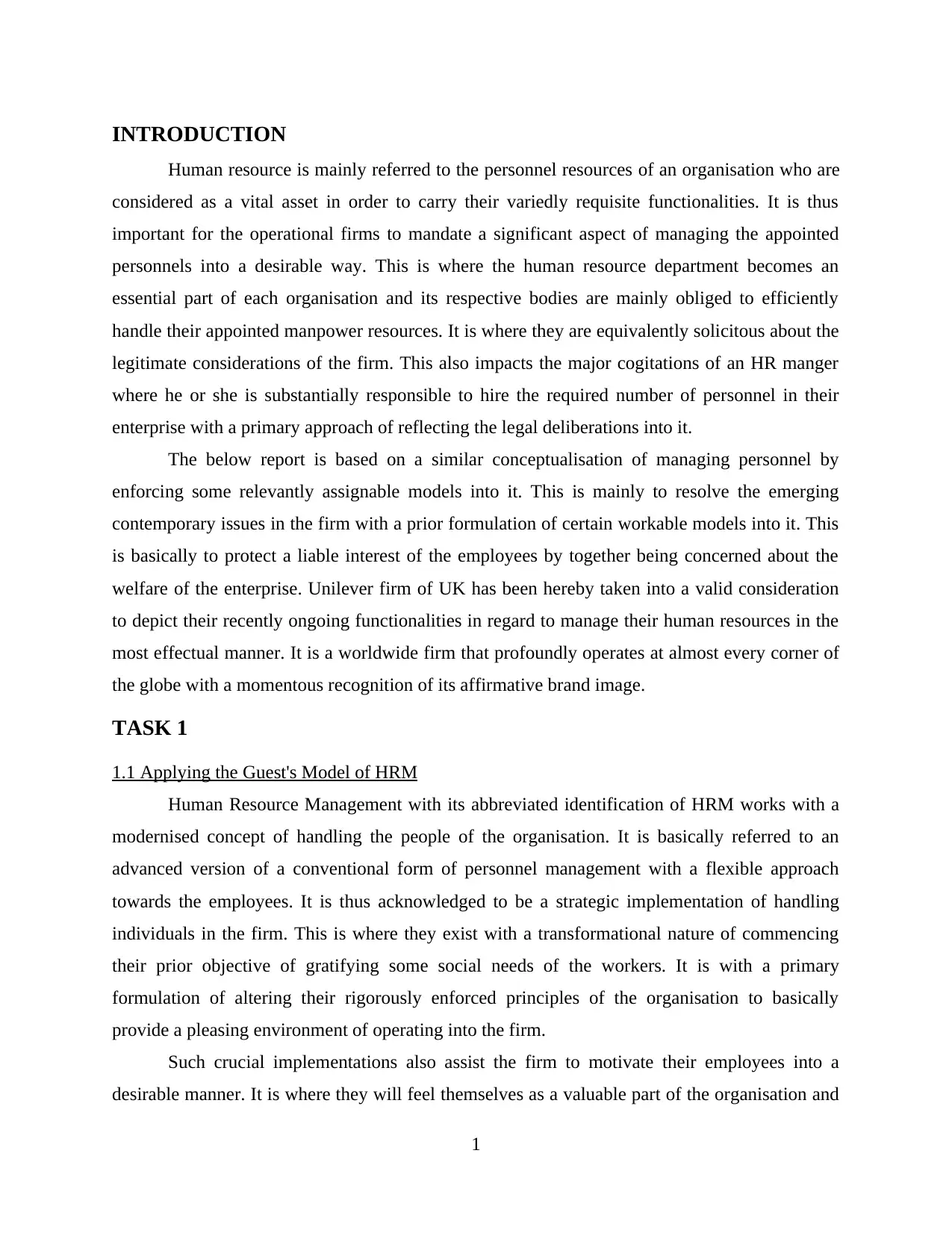
INTRODUCTION
Human resource is mainly referred to the personnel resources of an organisation who are
considered as a vital asset in order to carry their variedly requisite functionalities. It is thus
important for the operational firms to mandate a significant aspect of managing the appointed
personnels into a desirable way. This is where the human resource department becomes an
essential part of each organisation and its respective bodies are mainly obliged to efficiently
handle their appointed manpower resources. It is where they are equivalently solicitous about the
legitimate considerations of the firm. This also impacts the major cogitations of an HR manger
where he or she is substantially responsible to hire the required number of personnel in their
enterprise with a primary approach of reflecting the legal deliberations into it.
The below report is based on a similar conceptualisation of managing personnel by
enforcing some relevantly assignable models into it. This is mainly to resolve the emerging
contemporary issues in the firm with a prior formulation of certain workable models into it. This
is basically to protect a liable interest of the employees by together being concerned about the
welfare of the enterprise. Unilever firm of UK has been hereby taken into a valid consideration
to depict their recently ongoing functionalities in regard to manage their human resources in the
most effectual manner. It is a worldwide firm that profoundly operates at almost every corner of
the globe with a momentous recognition of its affirmative brand image.
TASK 1
1.1 Applying the Guest's Model of HRM
Human Resource Management with its abbreviated identification of HRM works with a
modernised concept of handling the people of the organisation. It is basically referred to an
advanced version of a conventional form of personnel management with a flexible approach
towards the employees. It is thus acknowledged to be a strategic implementation of handling
individuals in the firm. This is where they exist with a transformational nature of commencing
their prior objective of gratifying some social needs of the workers. It is with a primary
formulation of altering their rigorously enforced principles of the organisation to basically
provide a pleasing environment of operating into the firm.
Such crucial implementations also assist the firm to motivate their employees into a
desirable manner. It is where they will feel themselves as a valuable part of the organisation and
1
Human resource is mainly referred to the personnel resources of an organisation who are
considered as a vital asset in order to carry their variedly requisite functionalities. It is thus
important for the operational firms to mandate a significant aspect of managing the appointed
personnels into a desirable way. This is where the human resource department becomes an
essential part of each organisation and its respective bodies are mainly obliged to efficiently
handle their appointed manpower resources. It is where they are equivalently solicitous about the
legitimate considerations of the firm. This also impacts the major cogitations of an HR manger
where he or she is substantially responsible to hire the required number of personnel in their
enterprise with a primary approach of reflecting the legal deliberations into it.
The below report is based on a similar conceptualisation of managing personnel by
enforcing some relevantly assignable models into it. This is mainly to resolve the emerging
contemporary issues in the firm with a prior formulation of certain workable models into it. This
is basically to protect a liable interest of the employees by together being concerned about the
welfare of the enterprise. Unilever firm of UK has been hereby taken into a valid consideration
to depict their recently ongoing functionalities in regard to manage their human resources in the
most effectual manner. It is a worldwide firm that profoundly operates at almost every corner of
the globe with a momentous recognition of its affirmative brand image.
TASK 1
1.1 Applying the Guest's Model of HRM
Human Resource Management with its abbreviated identification of HRM works with a
modernised concept of handling the people of the organisation. It is basically referred to an
advanced version of a conventional form of personnel management with a flexible approach
towards the employees. It is thus acknowledged to be a strategic implementation of handling
individuals in the firm. This is where they exist with a transformational nature of commencing
their prior objective of gratifying some social needs of the workers. It is with a primary
formulation of altering their rigorously enforced principles of the organisation to basically
provide a pleasing environment of operating into the firm.
Such crucial implementations also assist the firm to motivate their employees into a
desirable manner. It is where they will feel themselves as a valuable part of the organisation and
1
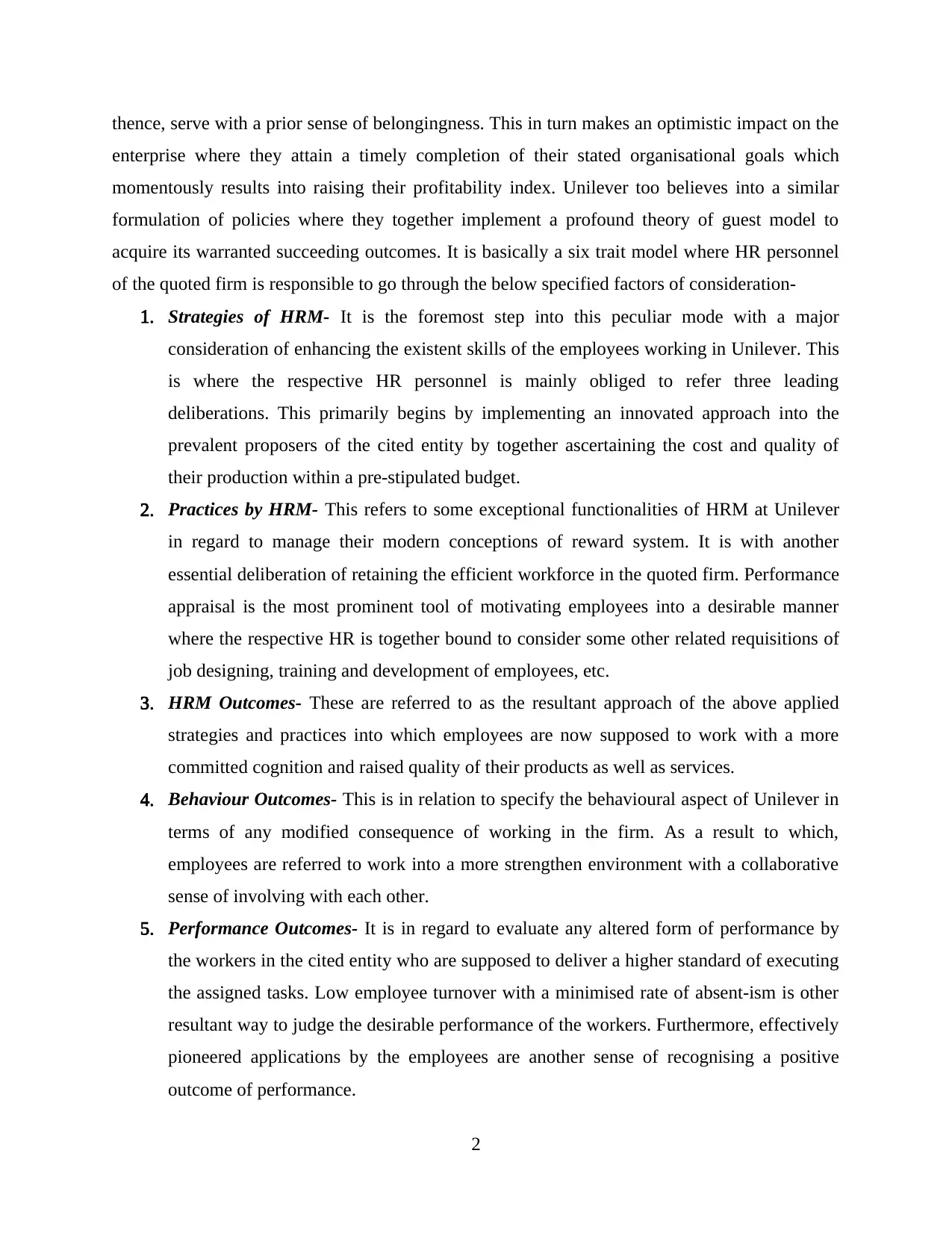
thence, serve with a prior sense of belongingness. This in turn makes an optimistic impact on the
enterprise where they attain a timely completion of their stated organisational goals which
momentously results into raising their profitability index. Unilever too believes into a similar
formulation of policies where they together implement a profound theory of guest model to
acquire its warranted succeeding outcomes. It is basically a six trait model where HR personnel
of the quoted firm is responsible to go through the below specified factors of consideration-
1. Strategies of HRM- It is the foremost step into this peculiar mode with a major
consideration of enhancing the existent skills of the employees working in Unilever. This
is where the respective HR personnel is mainly obliged to refer three leading
deliberations. This primarily begins by implementing an innovated approach into the
prevalent proposers of the cited entity by together ascertaining the cost and quality of
their production within a pre-stipulated budget.
2. Practices by HRM- This refers to some exceptional functionalities of HRM at Unilever
in regard to manage their modern conceptions of reward system. It is with another
essential deliberation of retaining the efficient workforce in the quoted firm. Performance
appraisal is the most prominent tool of motivating employees into a desirable manner
where the respective HR is together bound to consider some other related requisitions of
job designing, training and development of employees, etc.
3. HRM Outcomes- These are referred to as the resultant approach of the above applied
strategies and practices into which employees are now supposed to work with a more
committed cognition and raised quality of their products as well as services.
4. Behaviour Outcomes- This is in relation to specify the behavioural aspect of Unilever in
terms of any modified consequence of working in the firm. As a result to which,
employees are referred to work into a more strengthen environment with a collaborative
sense of involving with each other.
5. Performance Outcomes- It is in regard to evaluate any altered form of performance by
the workers in the cited entity who are supposed to deliver a higher standard of executing
the assigned tasks. Low employee turnover with a minimised rate of absent-ism is other
resultant way to judge the desirable performance of the workers. Furthermore, effectively
pioneered applications by the employees are another sense of recognising a positive
outcome of performance.
2
enterprise where they attain a timely completion of their stated organisational goals which
momentously results into raising their profitability index. Unilever too believes into a similar
formulation of policies where they together implement a profound theory of guest model to
acquire its warranted succeeding outcomes. It is basically a six trait model where HR personnel
of the quoted firm is responsible to go through the below specified factors of consideration-
1. Strategies of HRM- It is the foremost step into this peculiar mode with a major
consideration of enhancing the existent skills of the employees working in Unilever. This
is where the respective HR personnel is mainly obliged to refer three leading
deliberations. This primarily begins by implementing an innovated approach into the
prevalent proposers of the cited entity by together ascertaining the cost and quality of
their production within a pre-stipulated budget.
2. Practices by HRM- This refers to some exceptional functionalities of HRM at Unilever
in regard to manage their modern conceptions of reward system. It is with another
essential deliberation of retaining the efficient workforce in the quoted firm. Performance
appraisal is the most prominent tool of motivating employees into a desirable manner
where the respective HR is together bound to consider some other related requisitions of
job designing, training and development of employees, etc.
3. HRM Outcomes- These are referred to as the resultant approach of the above applied
strategies and practices into which employees are now supposed to work with a more
committed cognition and raised quality of their products as well as services.
4. Behaviour Outcomes- This is in relation to specify the behavioural aspect of Unilever in
terms of any modified consequence of working in the firm. As a result to which,
employees are referred to work into a more strengthen environment with a collaborative
sense of involving with each other.
5. Performance Outcomes- It is in regard to evaluate any altered form of performance by
the workers in the cited entity who are supposed to deliver a higher standard of executing
the assigned tasks. Low employee turnover with a minimised rate of absent-ism is other
resultant way to judge the desirable performance of the workers. Furthermore, effectively
pioneered applications by the employees are another sense of recognising a positive
outcome of performance.
2
⊘ This is a preview!⊘
Do you want full access?
Subscribe today to unlock all pages.

Trusted by 1+ million students worldwide
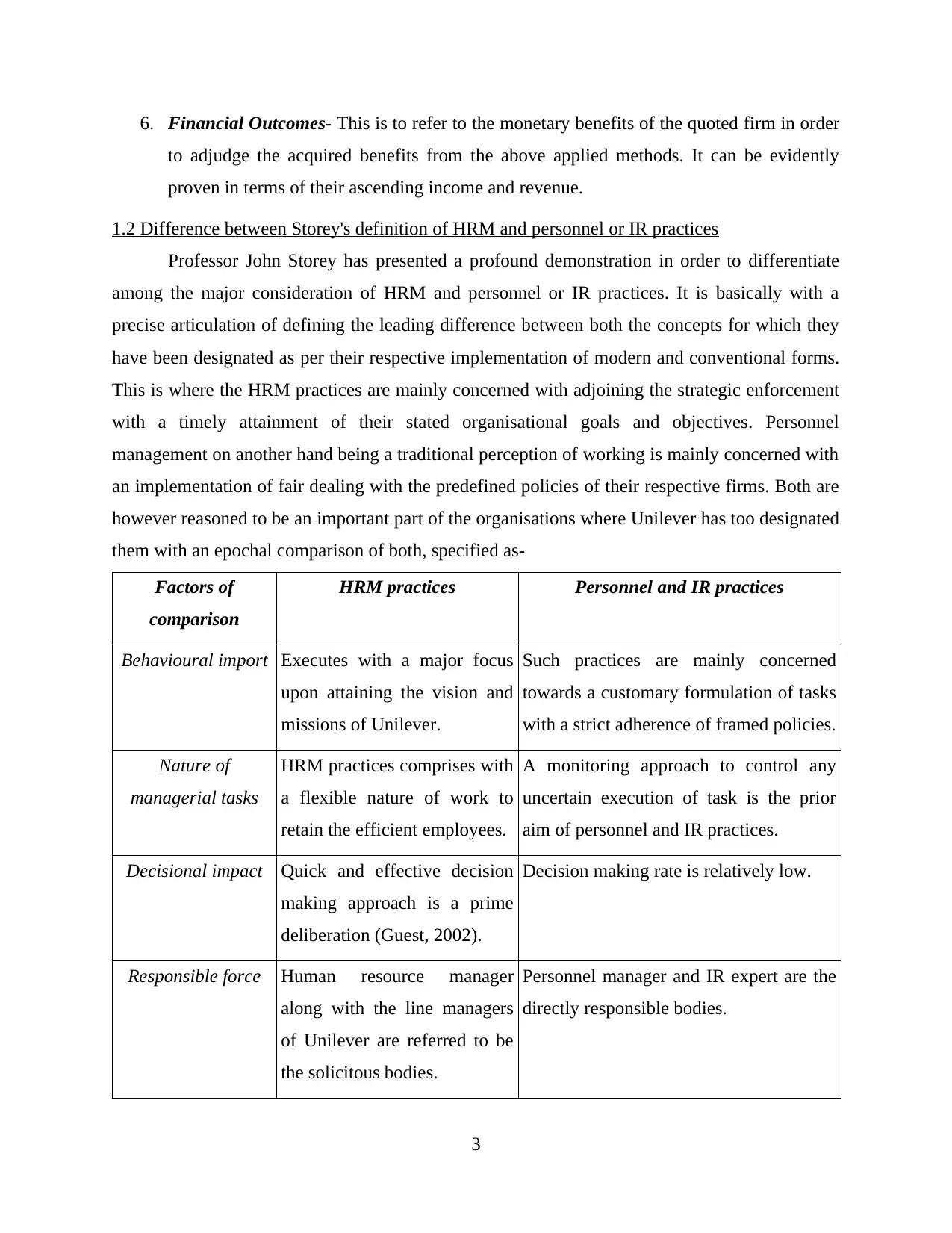
6. Financial Outcomes- This is to refer to the monetary benefits of the quoted firm in order
to adjudge the acquired benefits from the above applied methods. It can be evidently
proven in terms of their ascending income and revenue.
1.2 Difference between Storey's definition of HRM and personnel or IR practices
Professor John Storey has presented a profound demonstration in order to differentiate
among the major consideration of HRM and personnel or IR practices. It is basically with a
precise articulation of defining the leading difference between both the concepts for which they
have been designated as per their respective implementation of modern and conventional forms.
This is where the HRM practices are mainly concerned with adjoining the strategic enforcement
with a timely attainment of their stated organisational goals and objectives. Personnel
management on another hand being a traditional perception of working is mainly concerned with
an implementation of fair dealing with the predefined policies of their respective firms. Both are
however reasoned to be an important part of the organisations where Unilever has too designated
them with an epochal comparison of both, specified as-
Factors of
comparison
HRM practices Personnel and IR practices
Behavioural import Executes with a major focus
upon attaining the vision and
missions of Unilever.
Such practices are mainly concerned
towards a customary formulation of tasks
with a strict adherence of framed policies.
Nature of
managerial tasks
HRM practices comprises with
a flexible nature of work to
retain the efficient employees.
A monitoring approach to control any
uncertain execution of task is the prior
aim of personnel and IR practices.
Decisional impact Quick and effective decision
making approach is a prime
deliberation (Guest, 2002).
Decision making rate is relatively low.
Responsible force Human resource manager
along with the line managers
of Unilever are referred to be
the solicitous bodies.
Personnel manager and IR expert are the
directly responsible bodies.
3
to adjudge the acquired benefits from the above applied methods. It can be evidently
proven in terms of their ascending income and revenue.
1.2 Difference between Storey's definition of HRM and personnel or IR practices
Professor John Storey has presented a profound demonstration in order to differentiate
among the major consideration of HRM and personnel or IR practices. It is basically with a
precise articulation of defining the leading difference between both the concepts for which they
have been designated as per their respective implementation of modern and conventional forms.
This is where the HRM practices are mainly concerned with adjoining the strategic enforcement
with a timely attainment of their stated organisational goals and objectives. Personnel
management on another hand being a traditional perception of working is mainly concerned with
an implementation of fair dealing with the predefined policies of their respective firms. Both are
however reasoned to be an important part of the organisations where Unilever has too designated
them with an epochal comparison of both, specified as-
Factors of
comparison
HRM practices Personnel and IR practices
Behavioural import Executes with a major focus
upon attaining the vision and
missions of Unilever.
Such practices are mainly concerned
towards a customary formulation of tasks
with a strict adherence of framed policies.
Nature of
managerial tasks
HRM practices comprises with
a flexible nature of work to
retain the efficient employees.
A monitoring approach to control any
uncertain execution of task is the prior
aim of personnel and IR practices.
Decisional impact Quick and effective decision
making approach is a prime
deliberation (Guest, 2002).
Decision making rate is relatively low.
Responsible force Human resource manager
along with the line managers
of Unilever are referred to be
the solicitous bodies.
Personnel manager and IR expert are the
directly responsible bodies.
3
Paraphrase This Document
Need a fresh take? Get an instant paraphrase of this document with our AI Paraphraser
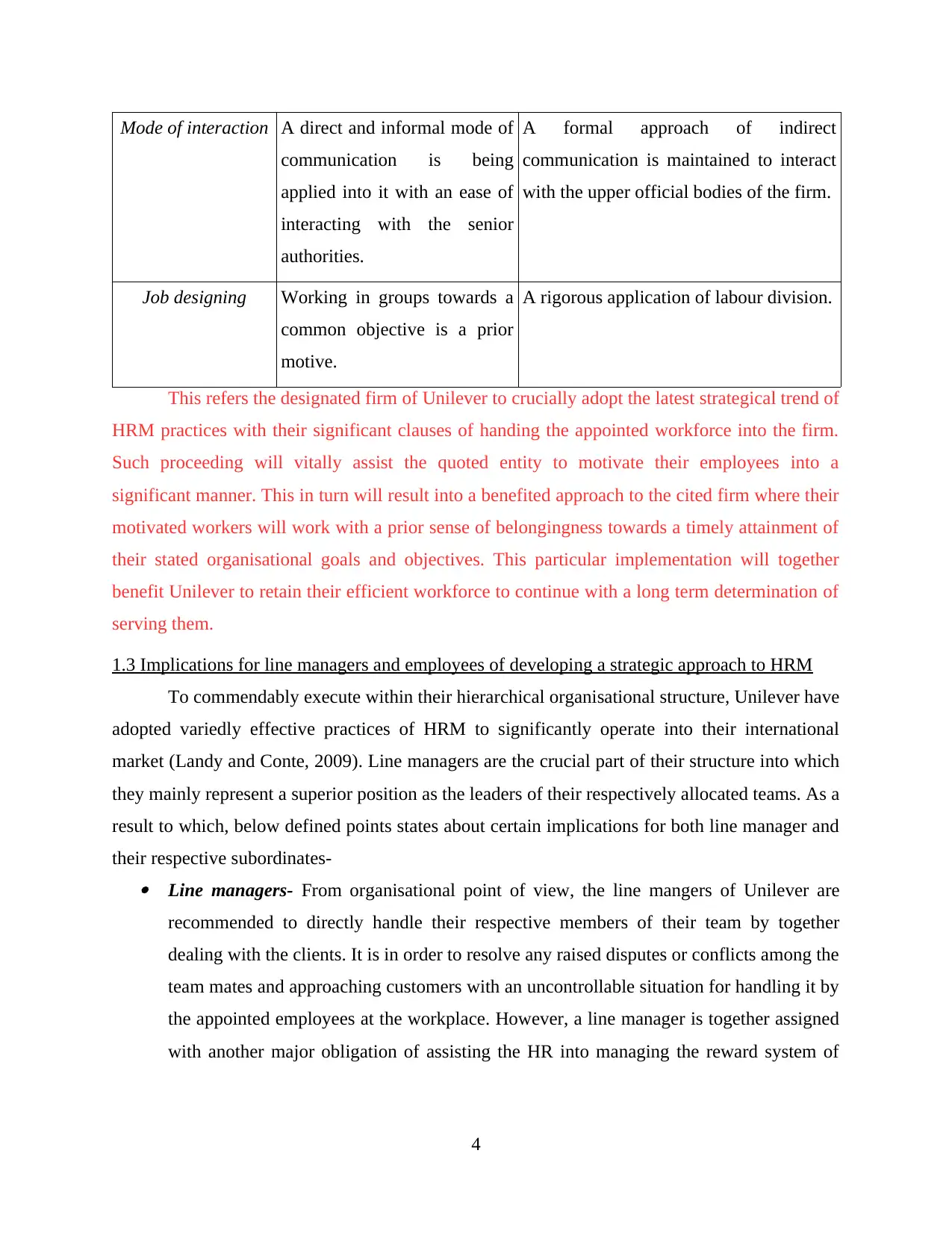
Mode of interaction A direct and informal mode of
communication is being
applied into it with an ease of
interacting with the senior
authorities.
A formal approach of indirect
communication is maintained to interact
with the upper official bodies of the firm.
Job designing Working in groups towards a
common objective is a prior
motive.
A rigorous application of labour division.
This refers the designated firm of Unilever to crucially adopt the latest strategical trend of
HRM practices with their significant clauses of handing the appointed workforce into the firm.
Such proceeding will vitally assist the quoted entity to motivate their employees into a
significant manner. This in turn will result into a benefited approach to the cited firm where their
motivated workers will work with a prior sense of belongingness towards a timely attainment of
their stated organisational goals and objectives. This particular implementation will together
benefit Unilever to retain their efficient workforce to continue with a long term determination of
serving them.
1.3 Implications for line managers and employees of developing a strategic approach to HRM
To commendably execute within their hierarchical organisational structure, Unilever have
adopted variedly effective practices of HRM to significantly operate into their international
market (Landy and Conte, 2009). Line managers are the crucial part of their structure into which
they mainly represent a superior position as the leaders of their respectively allocated teams. As a
result to which, below defined points states about certain implications for both line manager and
their respective subordinates- Line managers- From organisational point of view, the line mangers of Unilever are
recommended to directly handle their respective members of their team by together
dealing with the clients. It is in order to resolve any raised disputes or conflicts among the
team mates and approaching customers with an uncontrollable situation for handling it by
the appointed employees at the workplace. However, a line manager is together assigned
with another major obligation of assisting the HR into managing the reward system of
4
communication is being
applied into it with an ease of
interacting with the senior
authorities.
A formal approach of indirect
communication is maintained to interact
with the upper official bodies of the firm.
Job designing Working in groups towards a
common objective is a prior
motive.
A rigorous application of labour division.
This refers the designated firm of Unilever to crucially adopt the latest strategical trend of
HRM practices with their significant clauses of handing the appointed workforce into the firm.
Such proceeding will vitally assist the quoted entity to motivate their employees into a
significant manner. This in turn will result into a benefited approach to the cited firm where their
motivated workers will work with a prior sense of belongingness towards a timely attainment of
their stated organisational goals and objectives. This particular implementation will together
benefit Unilever to retain their efficient workforce to continue with a long term determination of
serving them.
1.3 Implications for line managers and employees of developing a strategic approach to HRM
To commendably execute within their hierarchical organisational structure, Unilever have
adopted variedly effective practices of HRM to significantly operate into their international
market (Landy and Conte, 2009). Line managers are the crucial part of their structure into which
they mainly represent a superior position as the leaders of their respectively allocated teams. As a
result to which, below defined points states about certain implications for both line manager and
their respective subordinates- Line managers- From organisational point of view, the line mangers of Unilever are
recommended to directly handle their respective members of their team by together
dealing with the clients. It is in order to resolve any raised disputes or conflicts among the
team mates and approaching customers with an uncontrollable situation for handling it by
the appointed employees at the workplace. However, a line manager is together assigned
with another major obligation of assisting the HR into managing the reward system of
4
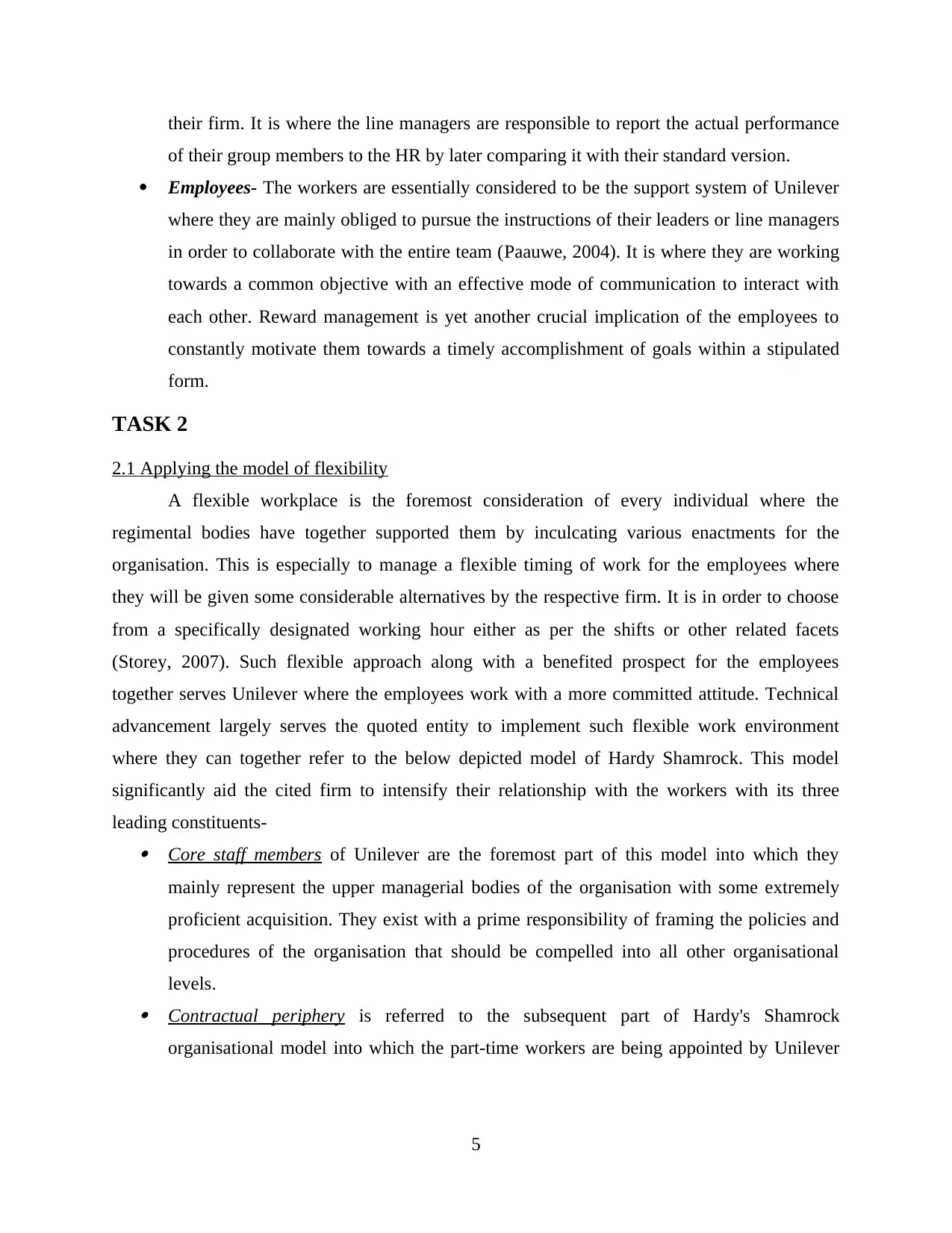
their firm. It is where the line managers are responsible to report the actual performance
of their group members to the HR by later comparing it with their standard version.
Employees- The workers are essentially considered to be the support system of Unilever
where they are mainly obliged to pursue the instructions of their leaders or line managers
in order to collaborate with the entire team (Paauwe, 2004). It is where they are working
towards a common objective with an effective mode of communication to interact with
each other. Reward management is yet another crucial implication of the employees to
constantly motivate them towards a timely accomplishment of goals within a stipulated
form.
TASK 2
2.1 Applying the model of flexibility
A flexible workplace is the foremost consideration of every individual where the
regimental bodies have together supported them by inculcating various enactments for the
organisation. This is especially to manage a flexible timing of work for the employees where
they will be given some considerable alternatives by the respective firm. It is in order to choose
from a specifically designated working hour either as per the shifts or other related facets
(Storey, 2007). Such flexible approach along with a benefited prospect for the employees
together serves Unilever where the employees work with a more committed attitude. Technical
advancement largely serves the quoted entity to implement such flexible work environment
where they can together refer to the below depicted model of Hardy Shamrock. This model
significantly aid the cited firm to intensify their relationship with the workers with its three
leading constituents- Core staff members of Unilever are the foremost part of this model into which they
mainly represent the upper managerial bodies of the organisation with some extremely
proficient acquisition. They exist with a prime responsibility of framing the policies and
procedures of the organisation that should be compelled into all other organisational
levels. Contractual periphery is referred to the subsequent part of Hardy's Shamrock
organisational model into which the part-time workers are being appointed by Unilever
5
of their group members to the HR by later comparing it with their standard version.
Employees- The workers are essentially considered to be the support system of Unilever
where they are mainly obliged to pursue the instructions of their leaders or line managers
in order to collaborate with the entire team (Paauwe, 2004). It is where they are working
towards a common objective with an effective mode of communication to interact with
each other. Reward management is yet another crucial implication of the employees to
constantly motivate them towards a timely accomplishment of goals within a stipulated
form.
TASK 2
2.1 Applying the model of flexibility
A flexible workplace is the foremost consideration of every individual where the
regimental bodies have together supported them by inculcating various enactments for the
organisation. This is especially to manage a flexible timing of work for the employees where
they will be given some considerable alternatives by the respective firm. It is in order to choose
from a specifically designated working hour either as per the shifts or other related facets
(Storey, 2007). Such flexible approach along with a benefited prospect for the employees
together serves Unilever where the employees work with a more committed attitude. Technical
advancement largely serves the quoted entity to implement such flexible work environment
where they can together refer to the below depicted model of Hardy Shamrock. This model
significantly aid the cited firm to intensify their relationship with the workers with its three
leading constituents- Core staff members of Unilever are the foremost part of this model into which they
mainly represent the upper managerial bodies of the organisation with some extremely
proficient acquisition. They exist with a prime responsibility of framing the policies and
procedures of the organisation that should be compelled into all other organisational
levels. Contractual periphery is referred to the subsequent part of Hardy's Shamrock
organisational model into which the part-time workers are being appointed by Unilever
5
⊘ This is a preview!⊘
Do you want full access?
Subscribe today to unlock all pages.

Trusted by 1+ million students worldwide
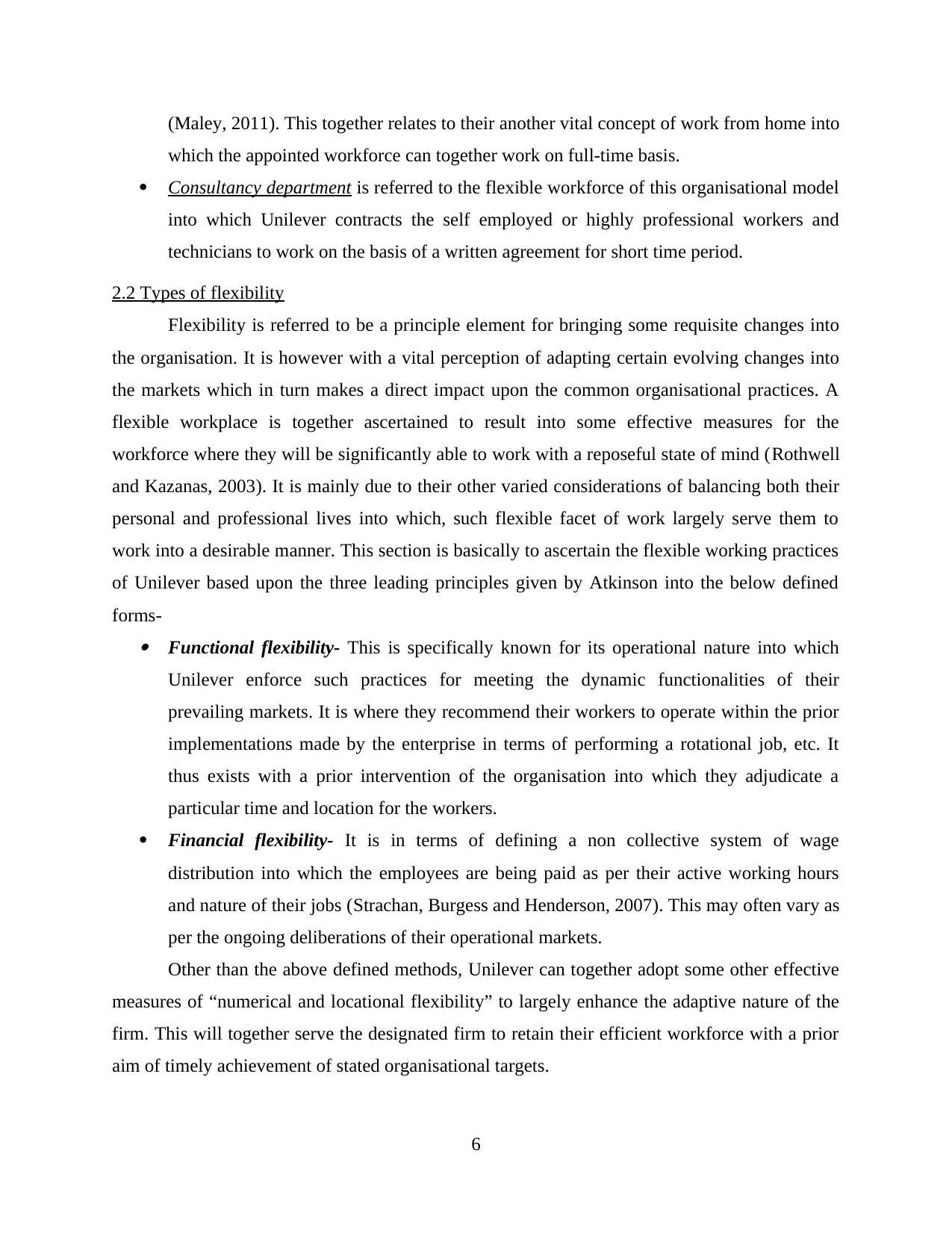
(Maley, 2011). This together relates to their another vital concept of work from home into
which the appointed workforce can together work on full-time basis.
Consultancy department is referred to the flexible workforce of this organisational model
into which Unilever contracts the self employed or highly professional workers and
technicians to work on the basis of a written agreement for short time period.
2.2 Types of flexibility
Flexibility is referred to be a principle element for bringing some requisite changes into
the organisation. It is however with a vital perception of adapting certain evolving changes into
the markets which in turn makes a direct impact upon the common organisational practices. A
flexible workplace is together ascertained to result into some effective measures for the
workforce where they will be significantly able to work with a reposeful state of mind (Rothwell
and Kazanas, 2003). It is mainly due to their other varied considerations of balancing both their
personal and professional lives into which, such flexible facet of work largely serve them to
work into a desirable manner. This section is basically to ascertain the flexible working practices
of Unilever based upon the three leading principles given by Atkinson into the below defined
forms- Functional flexibility- This is specifically known for its operational nature into which
Unilever enforce such practices for meeting the dynamic functionalities of their
prevailing markets. It is where they recommend their workers to operate within the prior
implementations made by the enterprise in terms of performing a rotational job, etc. It
thus exists with a prior intervention of the organisation into which they adjudicate a
particular time and location for the workers.
Financial flexibility- It is in terms of defining a non collective system of wage
distribution into which the employees are being paid as per their active working hours
and nature of their jobs (Strachan, Burgess and Henderson, 2007). This may often vary as
per the ongoing deliberations of their operational markets.
Other than the above defined methods, Unilever can together adopt some other effective
measures of “numerical and locational flexibility” to largely enhance the adaptive nature of the
firm. This will together serve the designated firm to retain their efficient workforce with a prior
aim of timely achievement of stated organisational targets.
6
which the appointed workforce can together work on full-time basis.
Consultancy department is referred to the flexible workforce of this organisational model
into which Unilever contracts the self employed or highly professional workers and
technicians to work on the basis of a written agreement for short time period.
2.2 Types of flexibility
Flexibility is referred to be a principle element for bringing some requisite changes into
the organisation. It is however with a vital perception of adapting certain evolving changes into
the markets which in turn makes a direct impact upon the common organisational practices. A
flexible workplace is together ascertained to result into some effective measures for the
workforce where they will be significantly able to work with a reposeful state of mind (Rothwell
and Kazanas, 2003). It is mainly due to their other varied considerations of balancing both their
personal and professional lives into which, such flexible facet of work largely serve them to
work into a desirable manner. This section is basically to ascertain the flexible working practices
of Unilever based upon the three leading principles given by Atkinson into the below defined
forms- Functional flexibility- This is specifically known for its operational nature into which
Unilever enforce such practices for meeting the dynamic functionalities of their
prevailing markets. It is where they recommend their workers to operate within the prior
implementations made by the enterprise in terms of performing a rotational job, etc. It
thus exists with a prior intervention of the organisation into which they adjudicate a
particular time and location for the workers.
Financial flexibility- It is in terms of defining a non collective system of wage
distribution into which the employees are being paid as per their active working hours
and nature of their jobs (Strachan, Burgess and Henderson, 2007). This may often vary as
per the ongoing deliberations of their operational markets.
Other than the above defined methods, Unilever can together adopt some other effective
measures of “numerical and locational flexibility” to largely enhance the adaptive nature of the
firm. This will together serve the designated firm to retain their efficient workforce with a prior
aim of timely achievement of stated organisational targets.
6
Paraphrase This Document
Need a fresh take? Get an instant paraphrase of this document with our AI Paraphraser
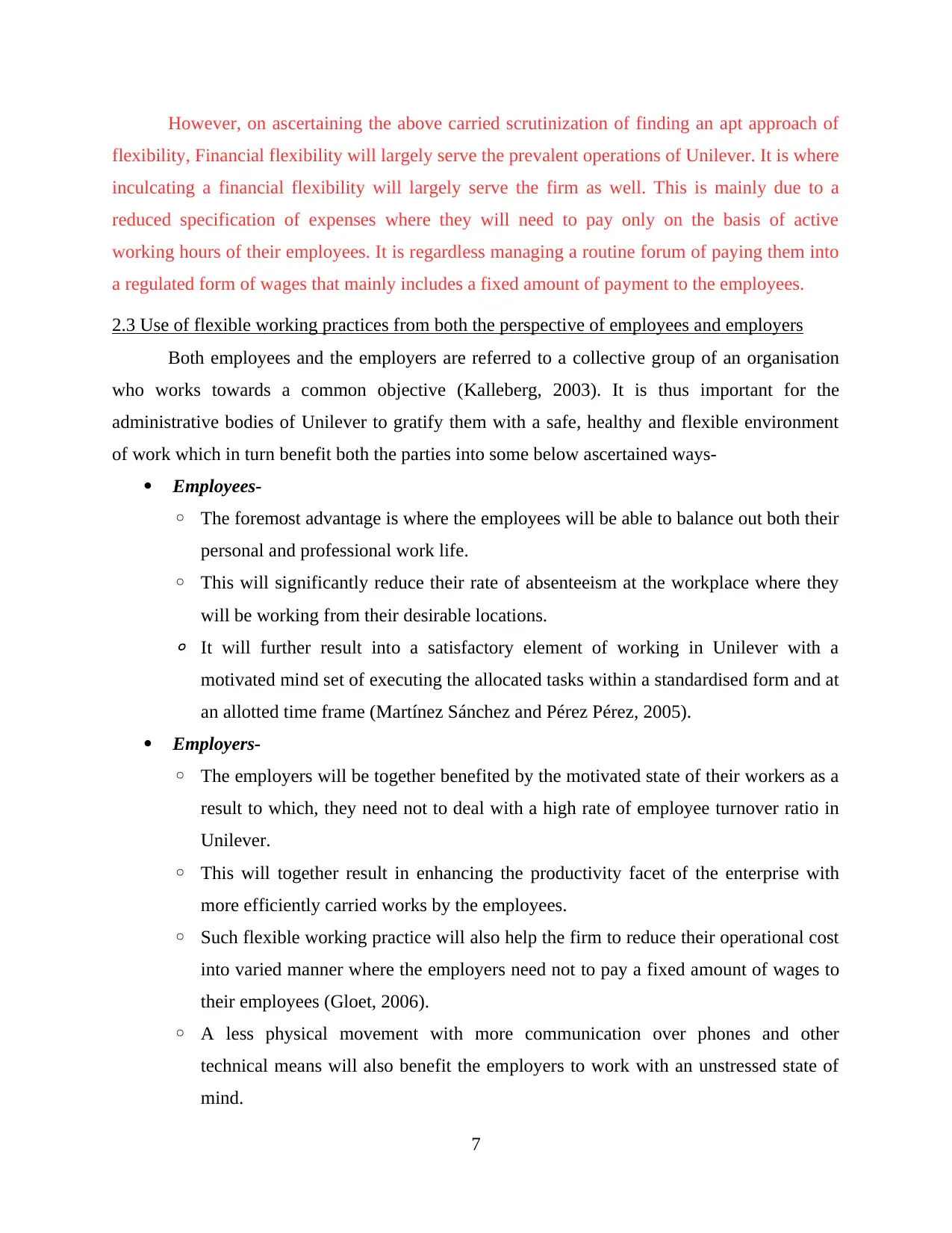
However, on ascertaining the above carried scrutinization of finding an apt approach of
flexibility, Financial flexibility will largely serve the prevalent operations of Unilever. It is where
inculcating a financial flexibility will largely serve the firm as well. This is mainly due to a
reduced specification of expenses where they will need to pay only on the basis of active
working hours of their employees. It is regardless managing a routine forum of paying them into
a regulated form of wages that mainly includes a fixed amount of payment to the employees.
2.3 Use of flexible working practices from both the perspective of employees and employers
Both employees and the employers are referred to a collective group of an organisation
who works towards a common objective (Kalleberg, 2003). It is thus important for the
administrative bodies of Unilever to gratify them with a safe, healthy and flexible environment
of work which in turn benefit both the parties into some below ascertained ways-
Employees-
◦ The foremost advantage is where the employees will be able to balance out both their
personal and professional work life.
◦ This will significantly reduce their rate of absenteeism at the workplace where they
will be working from their desirable locations.
◦ It will further result into a satisfactory element of working in Unilever with a
motivated mind set of executing the allocated tasks within a standardised form and at
an allotted time frame (Martínez Sánchez and Pérez Pérez, 2005).
Employers-
◦ The employers will be together benefited by the motivated state of their workers as a
result to which, they need not to deal with a high rate of employee turnover ratio in
Unilever.
◦ This will together result in enhancing the productivity facet of the enterprise with
more efficiently carried works by the employees.
◦ Such flexible working practice will also help the firm to reduce their operational cost
into varied manner where the employers need not to pay a fixed amount of wages to
their employees (Gloet, 2006).
◦ A less physical movement with more communication over phones and other
technical means will also benefit the employers to work with an unstressed state of
mind.
7
flexibility, Financial flexibility will largely serve the prevalent operations of Unilever. It is where
inculcating a financial flexibility will largely serve the firm as well. This is mainly due to a
reduced specification of expenses where they will need to pay only on the basis of active
working hours of their employees. It is regardless managing a routine forum of paying them into
a regulated form of wages that mainly includes a fixed amount of payment to the employees.
2.3 Use of flexible working practices from both the perspective of employees and employers
Both employees and the employers are referred to a collective group of an organisation
who works towards a common objective (Kalleberg, 2003). It is thus important for the
administrative bodies of Unilever to gratify them with a safe, healthy and flexible environment
of work which in turn benefit both the parties into some below ascertained ways-
Employees-
◦ The foremost advantage is where the employees will be able to balance out both their
personal and professional work life.
◦ This will significantly reduce their rate of absenteeism at the workplace where they
will be working from their desirable locations.
◦ It will further result into a satisfactory element of working in Unilever with a
motivated mind set of executing the allocated tasks within a standardised form and at
an allotted time frame (Martínez Sánchez and Pérez Pérez, 2005).
Employers-
◦ The employers will be together benefited by the motivated state of their workers as a
result to which, they need not to deal with a high rate of employee turnover ratio in
Unilever.
◦ This will together result in enhancing the productivity facet of the enterprise with
more efficiently carried works by the employees.
◦ Such flexible working practice will also help the firm to reduce their operational cost
into varied manner where the employers need not to pay a fixed amount of wages to
their employees (Gloet, 2006).
◦ A less physical movement with more communication over phones and other
technical means will also benefit the employers to work with an unstressed state of
mind.
7
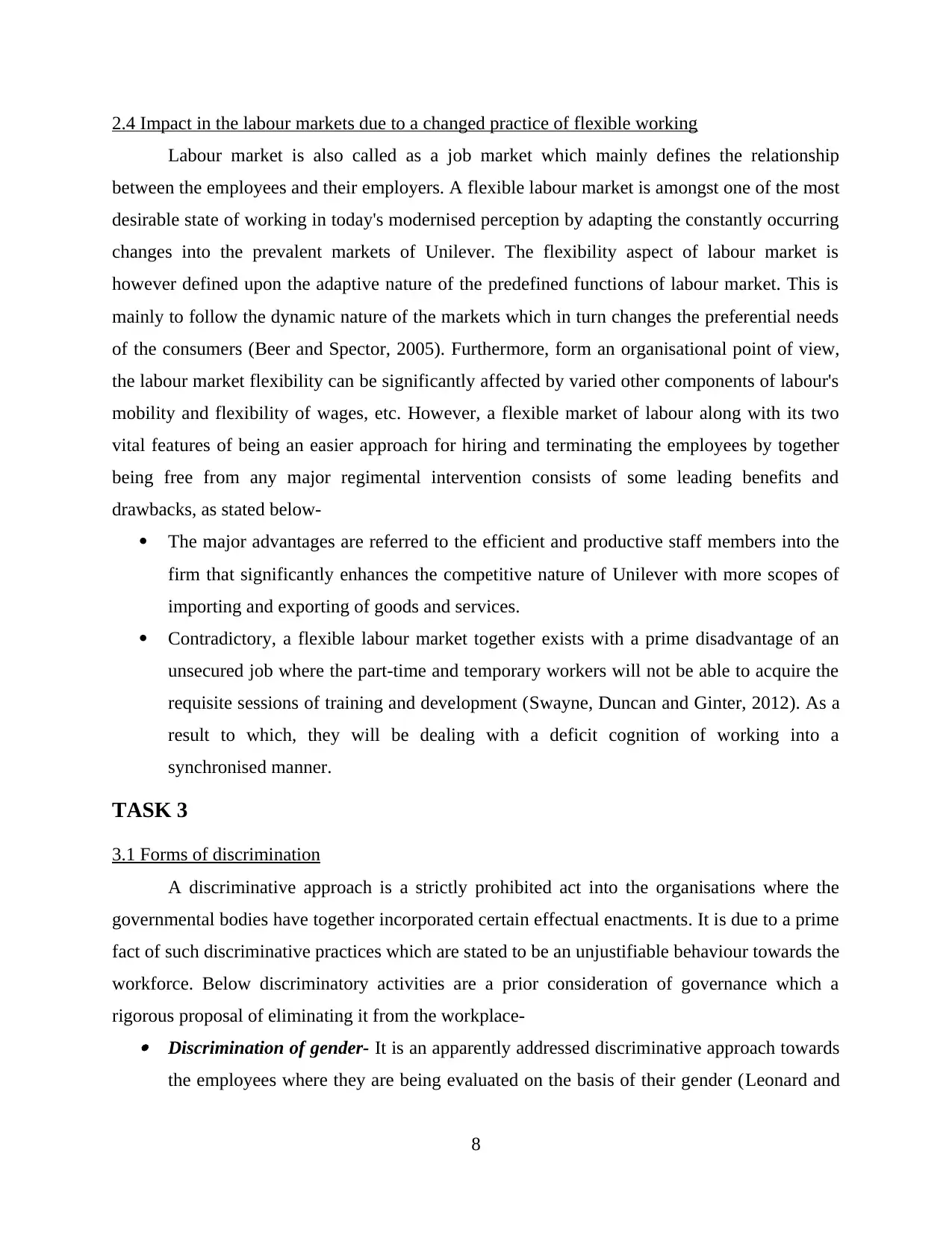
2.4 Impact in the labour markets due to a changed practice of flexible working
Labour market is also called as a job market which mainly defines the relationship
between the employees and their employers. A flexible labour market is amongst one of the most
desirable state of working in today's modernised perception by adapting the constantly occurring
changes into the prevalent markets of Unilever. The flexibility aspect of labour market is
however defined upon the adaptive nature of the predefined functions of labour market. This is
mainly to follow the dynamic nature of the markets which in turn changes the preferential needs
of the consumers (Beer and Spector, 2005). Furthermore, form an organisational point of view,
the labour market flexibility can be significantly affected by varied other components of labour's
mobility and flexibility of wages, etc. However, a flexible market of labour along with its two
vital features of being an easier approach for hiring and terminating the employees by together
being free from any major regimental intervention consists of some leading benefits and
drawbacks, as stated below-
The major advantages are referred to the efficient and productive staff members into the
firm that significantly enhances the competitive nature of Unilever with more scopes of
importing and exporting of goods and services.
Contradictory, a flexible labour market together exists with a prime disadvantage of an
unsecured job where the part-time and temporary workers will not be able to acquire the
requisite sessions of training and development (Swayne, Duncan and Ginter, 2012). As a
result to which, they will be dealing with a deficit cognition of working into a
synchronised manner.
TASK 3
3.1 Forms of discrimination
A discriminative approach is a strictly prohibited act into the organisations where the
governmental bodies have together incorporated certain effectual enactments. It is due to a prime
fact of such discriminative practices which are stated to be an unjustifiable behaviour towards the
workforce. Below discriminatory activities are a prior consideration of governance which a
rigorous proposal of eliminating it from the workplace- Discrimination of gender- It is an apparently addressed discriminative approach towards
the employees where they are being evaluated on the basis of their gender (Leonard and
8
Labour market is also called as a job market which mainly defines the relationship
between the employees and their employers. A flexible labour market is amongst one of the most
desirable state of working in today's modernised perception by adapting the constantly occurring
changes into the prevalent markets of Unilever. The flexibility aspect of labour market is
however defined upon the adaptive nature of the predefined functions of labour market. This is
mainly to follow the dynamic nature of the markets which in turn changes the preferential needs
of the consumers (Beer and Spector, 2005). Furthermore, form an organisational point of view,
the labour market flexibility can be significantly affected by varied other components of labour's
mobility and flexibility of wages, etc. However, a flexible market of labour along with its two
vital features of being an easier approach for hiring and terminating the employees by together
being free from any major regimental intervention consists of some leading benefits and
drawbacks, as stated below-
The major advantages are referred to the efficient and productive staff members into the
firm that significantly enhances the competitive nature of Unilever with more scopes of
importing and exporting of goods and services.
Contradictory, a flexible labour market together exists with a prime disadvantage of an
unsecured job where the part-time and temporary workers will not be able to acquire the
requisite sessions of training and development (Swayne, Duncan and Ginter, 2012). As a
result to which, they will be dealing with a deficit cognition of working into a
synchronised manner.
TASK 3
3.1 Forms of discrimination
A discriminative approach is a strictly prohibited act into the organisations where the
governmental bodies have together incorporated certain effectual enactments. It is due to a prime
fact of such discriminative practices which are stated to be an unjustifiable behaviour towards the
workforce. Below discriminatory activities are a prior consideration of governance which a
rigorous proposal of eliminating it from the workplace- Discrimination of gender- It is an apparently addressed discriminative approach towards
the employees where they are being evaluated on the basis of their gender (Leonard and
8
⊘ This is a preview!⊘
Do you want full access?
Subscribe today to unlock all pages.

Trusted by 1+ million students worldwide
1 out of 17
Related Documents
Your All-in-One AI-Powered Toolkit for Academic Success.
+13062052269
info@desklib.com
Available 24*7 on WhatsApp / Email
![[object Object]](/_next/static/media/star-bottom.7253800d.svg)
Unlock your academic potential
Copyright © 2020–2025 A2Z Services. All Rights Reserved. Developed and managed by ZUCOL.





